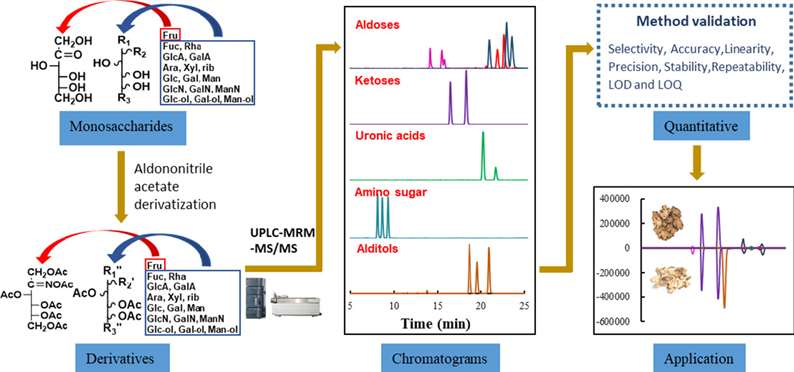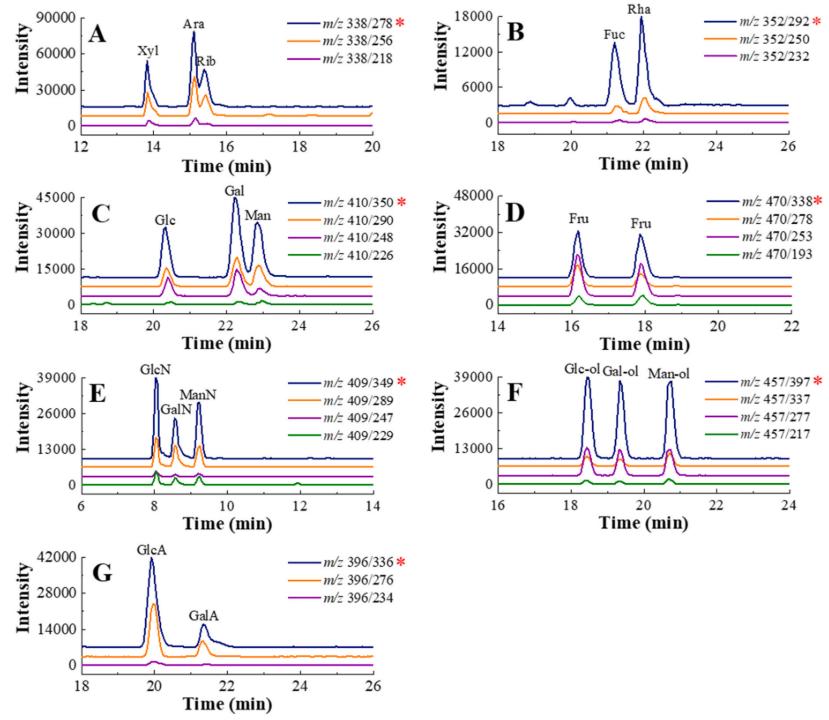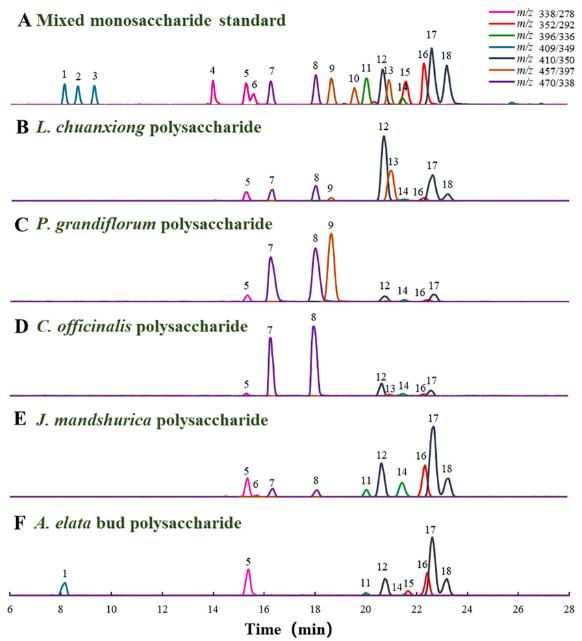- Service Details
- Case Study
Polysaccharides are complex carbohydrates composed of long chains of monosaccharide units linked together by glycosidic bonds. They play fundamental roles in biological systems, serving as structural components in cell walls, energy storage molecules, and signaling molecules in cellular recognition processes. Understanding the structure, composition, and properties of polysaccharides is essential for elucidating their biological functions and exploring their potential applications in various fields such as medicine, food science, and materials engineering.
Polysaccharide analysis is necessary to unravel the structural complexity and functional diversity of these macromolecules. Through analytical techniques such as chromatography, mass spectrometry, and spectroscopy, researchers can characterize polysaccharides in terms of their monosaccharide composition, molecular weight, branching patterns, and three-dimensional structures. This detailed analysis provides insights into polysaccharide biosynthesis, interactions with other biomolecules, and physiological functions, facilitating the development of polysaccharide-based therapeutics, biomaterials, and functional foods.
Polysaccharide Analysis Services in Creative Proteomics
- Polysaccharide Extraction and Purification: Our experts specialize in the extraction and purification of polysaccharides from diverse biological sources, including plants, animals, algae, and microorganisms. We employ optimized protocols and state-of-the-art techniques to obtain high-purity polysaccharide samples suitable for downstream analysis.
- Polysaccharide Composition Analysis: We provide comprehensive analysis of polysaccharide composition, including monosaccharide composition, linkage types, and branching patterns. Our advanced analytical methods, such as chromatography and spectroscopy, enable precise characterization of polysaccharide structures.
- Polysaccharide Methylation Analysis: Our experienced scientists utilize methylation analysis to elucidate the detailed structure of polysaccharides, including linkage positions and branching arrangements. This technique provides valuable insights into the structural diversity and complexity of polysaccharides.
- Polysaccharide Molecular Weight Determination: We offer accurate determination of polysaccharide molecular weights using various analytical approaches, such as gel permeation chromatography (GPC) and mass spectrometry. This information is crucial for understanding polysaccharide properties and functionalities.
- Polysaccharide Bioactivity Assays: Creative Proteomics conducts bioactivity assays to evaluate the functional properties of polysaccharides, such as immunomodulatory effects, antioxidant activity, and anti-inflammatory properties. These assays provide valuable data for assessing the potential therapeutic applications of polysaccharides.
- Polysaccharide Structure-Function Relationship Studies: Our team conducts in-depth studies to investigate the relationship between polysaccharide structure and biological activity. By correlating structural features with functional properties, we aim to elucidate the mechanisms underlying polysaccharide bioactivity and optimize their applications in various fields.
- Customized Polysaccharide Analysis Services: We understand that each polysaccharide sample may have unique characteristics and research objectives. Therefore, we offer customized analysis services tailored to the specific needs and requirements of our clients. Whether it's a routine analysis or a complex research project, our team is dedicated to delivering accurate and reliable results to advance your research goals.
Technical Platforms for Polysaccharide Analysis
Ultra-Performance Liquid Chromatography (UPLC®) System: UPLC systems offer exceptional resolution, sensitivity, and speed, enabling rapid separation and analysis of polysaccharides with high efficiency and reproducibility.
Fluorescence (FLR) Detection: FLR detection methods are utilized for enhanced sensitivity and selectivity in polysaccharide analysis. Detectors are optimized for multi-channel detection, facilitating precise quantification of polysaccharides derivatized with fluorescent tags.
Polysaccharide Chromatography Columns: Specialized chromatography columns, like the ACQUITY UPLC BEH Polysaccharide Chromatography Columns, ensure high-resolution separation of polysaccharide components, with superior peak shape, resolution, and reproducibility.
Mass Spectrometry (MS): State-of-the-art mass spectrometers provide accurate mass measurements for comprehensive structural analysis of polysaccharides, including molecular weight, composition, and linkage patterns.
Instrument Control Software: Advanced software platforms like MassLynxTM and EmpowerTM facilitate seamless operation, data acquisition, and analysis, ensuring efficient management and interpretation of polysaccharide analysis data.
List of Detectable Polysaccharide
| Cellulose | Starch | Glycogen | Chitin | Hyaluronic acid |
| Chondroitin sulfate | Heparin | Alginate | Agar | Xanthan gum |
| Pectin | Laminarin | Carrageenan | Dextran | Pullulan |
| Amylopectin | Amylose | Galactomannan | Galactan | Arabinogalactan |
| Inulin | Xylan | Mannan | Fructan | Arabinan |
| Lignin | Fucoidan | Glucuronoxylan | Galacturonan | Mucilage |
| β-glucan | Galactoglucomannan | Mannuronic acid | Guluronic acid | Arabinoxylan |
| Glucomannan | Curdlan | Hyaluronan | Acemannan | Konjac glucomannan |
| Konjac mannan | Hemicellulose | Heteropolysaccharide | Glycosaminoglycan |
Sample Requirements for Polysaccharide Analysis
| Sample Type | Recommended Sample Amount |
|---|---|
| Plant Tissues | 50-100 mg (dry weight) |
| Microbial Cultures | 1-2 mL (liquid culture) or 10-50 mg (dry biomass) |
| Animal Tissues | 20-50 mg (dry weight) |
| Food Products | Variable, depending on the product |
| Environmental Samples | Variable, depending on the sample matrix |
| Biomedical Samples | Variable, depending on the sample source |
| Synthetic Polysaccharides | 10-20 mg (dry weight) |
Applications of Polysaccharide Analysis

Biomedical Research
- Drug Development: Investigates polysaccharides as drug candidates or delivery vehicles.
- Disease Diagnosis: Utilizes polysaccharides as biomarkers for diseases like cancer.
- Tissue Engineering: Ensures the integrity of polysaccharide-based scaffolds.

Food Industry
- Quality Control: Ensures food product quality and authenticity.
- Functional Properties: Optimizes food formulations for texture and stability.

Environmental Science
- Bioremediation: Assesses polysaccharide degradation kinetics in soil.
- Microbial Ecology: Studies polysaccharides in microbial biofilms.

Pharmaceutical Industry
- Formulation Development: Guarantees stability of polysaccharide-based formulations.
- Biological Activity: Characterizes polysaccharide activities like immunomodulation.
Title: Monosaccharides in Plant-Derived Polysaccharides Using LC-MS/MS with MRM Method
Background
Characterizing monosaccharide compositions in plant-derived polysaccharides is essential for understanding their physicochemical properties and biological activities. Traditional methods, such as GLC-MS and AND, face challenges in sensitivity and accuracy, necessitating the development of advanced analytical techniques.
Sample
Polysaccharide samples from various plants, including L. chuanxiong, P. grandiflorum, C. officinalis, J. mandshurica, and A. elata bud, were analyzed to assess monosaccharide compositions.
Technical Methods
Derivatization Principles Modification: The traditional AND (Aldose and Ketose) derivatization principles were modified to improve sensitivity and specificity for monosaccharide detection using LC-QTOF-MS. This modification enabled the differentiation between major products and byproducts, particularly for aldoses and ketoses.
Me-HCl Reaction Optimization: The Me-HCl reaction was optimized in terms of molarity and reaction time to enhance the sensitivity of uronic acids detection. This optimization involved investigating the effects of different Me-HCl concentrations and reaction durations on the sensitivity of monosaccharide detection, particularly focusing on uronic acids.
Determination of Quantitative and Qualitative MRM Ion Pairs: To achieve optimal sensitivity and reproducibility, LC-MRM-MS/MS was employed to determine the precursor ions (Q1) and product ions (Q3) of aldoses, ketoses, alditols, amino sugars, and uronic acids. The selection of appropriate Q1 ions, particularly sodiated precursor ions ([M + Na]+), and Q3 ions ([M + Na-HOAC]+) for quantification ensured accurate and reliable monosaccharide analysis.
LC and QQQ-MS Optimization: Various LC and QQQ-MS parameters, including column types, collision energy (CE), and declustering potential (DP), were optimized to improve resolution and sensitivity. Optimization of ESI-MS conditions, such as CE and DP, significantly influenced the sensitivity of MRM detection for monosaccharides.
Hydrolysis Conditions Optimization: Hydrolysis conditions using TFA were optimized in terms of TFA concentration, reaction time, and temperature to ensure efficient hydrolysis of polysaccharides while minimizing degradation, particularly of labile monosaccharides like fructose (Fru). Optimization of hydrolysis conditions was crucial for accurate determination of monosaccharide compositions in plant polysaccharides.

Results
The modified AND principles improved sensitivity for monosaccharide detection compared to GLC-MS. Optimization of Me-HCl reaction enhanced uronic acids detection. LC-MRM-MS/MS optimization ensured accurate determination of each carbohydrate without interferences. Further optimization of LC and QQQ-MS parameters improved resolution and sensitivity. Method validations demonstrated good linearity, LOD, LOQ, accuracy, precision, stability, and repeatability. Hydrolysis conditions were optimized for effective polysaccharide analysis.
 The qualitative and quantitative MRM chromatogram of each AND products of carbohydrates by QQQ-MS.
The qualitative and quantitative MRM chromatogram of each AND products of carbohydrates by QQQ-MS.
 The specificity results of LC-MS/MS chromatograms
The specificity results of LC-MS/MS chromatograms
Reference
- Li, Ye, et al. "A novel LC-MS/MS method for complete composition analysis of polysaccharides by aldononitrile acetate and multiple reaction monitoring." Carbohydrate Polymers 272 (2021): 118478.




